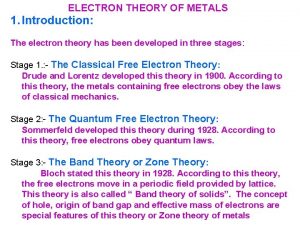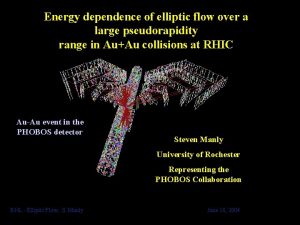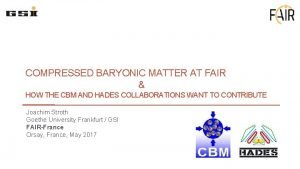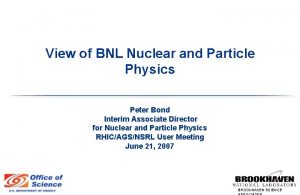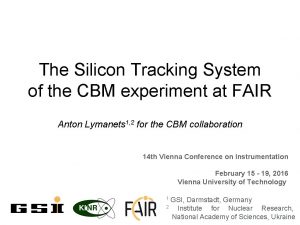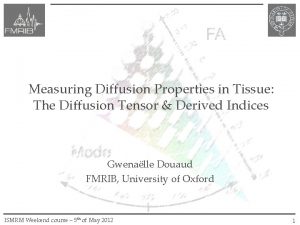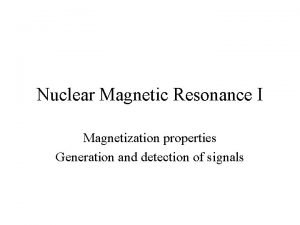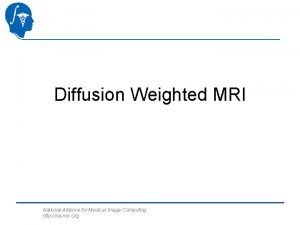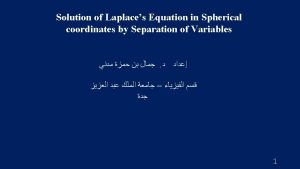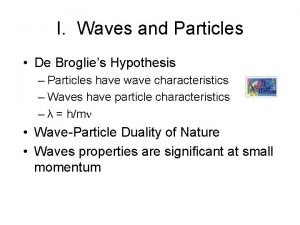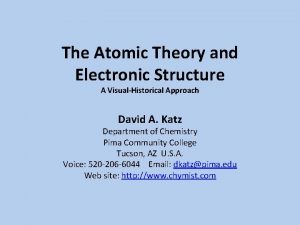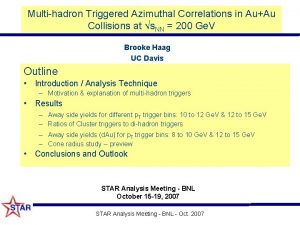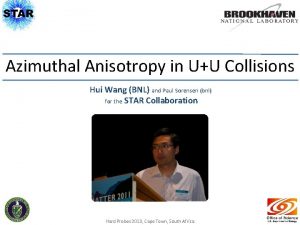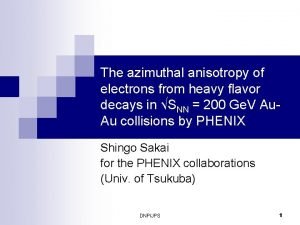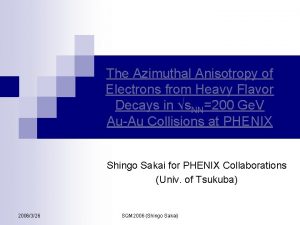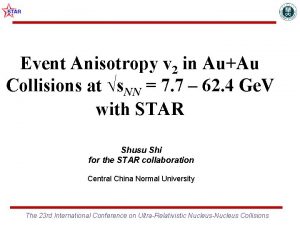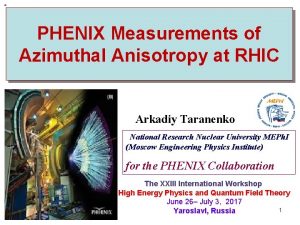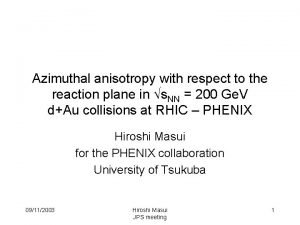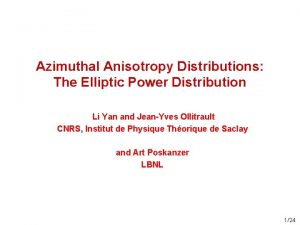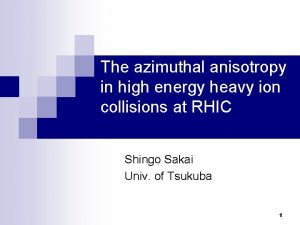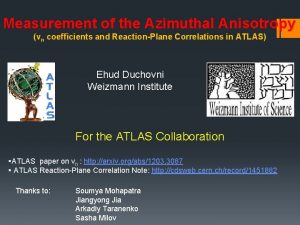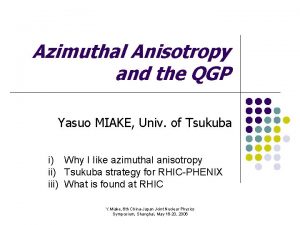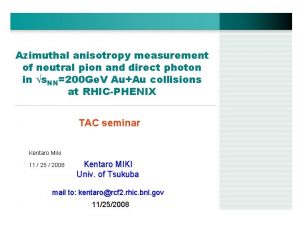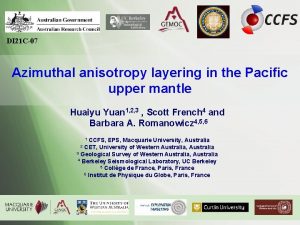Azimuthal anisotropy of electrons in AuAu collisions at














- Slides: 14

Azimuthal anisotropy of electrons in Au+Au collisions at √SNN=200 Ge. V/c measured with PHENIX at RHIC Shingo Sakai for PHENIX collaboration Univ. of Tsukuba

page 1 Abstract The measurement of electrons and positrons at transverse momenta above 1. 0 Ge. V/c allows to study the production of heavy flavor quark-anti quark pairs via the semileptonic decays of charmed particles [1]. The azimuthal anisotropy of high pt electrons can carry information about the anisotropy of the parent charmed mesons. The observation of charm flow would indicate that collective motion develops already in the partonic phase of the collision. [1] (PHENIX: PRL 88(2002)192303) *Detail of single electron studies and new results in 200 Ge. V Au+Au Takashi Hachiya’s Poster g conversion p 0 gee h gee, 3 p 0 w ee, p 0 ee f ee, hee r ee h’ gee

The PHENIX experiment has the unique capability to measure electrons and positrons at RHIC. In this analysis we study the elliptic flow pattern of inclusive electrons from Au+Au collisions at √SNN= 200 Ge. V as function of transverse momentum and estimate “nonphotonic” - charm & beauty - electron v 2 subtracted all other electron sources, such as Dalitz decays and photon conversions. c PYTHIA b direct g (J. Alam et al. PRC 63(2001)021901)

page 2 Overview of PHENIX • Reaction plane is determined by BBC • The tracking is done with DC+PC • In the PHENIX experiment electrons are identified as Cherenkov light by RICH - CO 2 - 0. 2 <pt <5. 0 (this analysis 0. 4<pt<4. 0) - |y| 0. 35

dn/d of e distribution In this analysis electron v 2 is estimated by using reaction plane method. (measure azimuthal angle of each electrons with respect to the reaction plane ) e+(e-) candidate Fig. shows the azimuthal distribution of electrons which is measured with respect to the reaction plane (upper red). The blue histogram is miss ID electron. The bottom distribution is result which is subtracted miss ID electron and fitted by dn/d = N(1+2 v 2 cos(2* )) Miss ID e+(e-) page 3

Pt dependence of e v 2 Fig. shows pt dependence electron v 2. The error bars reflect statistical errors only. The data points are plotted at the center of gravity of the bins as determined from the pt distribution and the horizontal error bar is RMS. The yellow line is systematic error. The electrons v 2 are including “photonic” & “nonphotonic” electrons v 2. Dalitz decays Di-electron decays Photon conversions Kaon decays Thermal dileptons charm decay beauty decay “photonic” “non-photonic” page 4

Comparison with v 2 of hadrons Fig. shows the comparison electron v 2 and hadron v 2 (pion, proton). @Low pt (pt<1. 0 Ge. V/c) v 2(e) is larger than v 2(pion)& v 2 (proton) @high pt region This region particular interest because of the contributions from heavy-quark (c/b) decays is large. ! v 2 page 5

Non-photonic electron v 2 In this analysis we compare with electron v 2 with simple model which is assuming charmed electron v 2 is zero. And we also estimate non-photonic electron v 2. The azimuthal distribution of electron gives as; dne/d = dnpho. /d + dnnon-pho. /d From the Eq. electron v 2 is given as; v 2(e) = rv 2(pho. )+(1 -r)v 2(non-pho. ). Here r is ratio of Ne/Npho. (shown right plot) and v 2(pho. ) is photonic e v 2. The value is estimated by simulation (next page ). ratio of Ne/Npho @√s. NN=200 Ge. V (T. Hachiya) page 6

(1) photonic e v 2 --- electron v 2 from π0 and K page 7 The dominant sources at low pt are photon conversions and Dalitz decays of pi 0 [1]. Electrons from Kaon decays contribute a few % at Low pt. These electrons are also taken into consideration. Electron v 2 from pi 0 and K is estimated by simulation. electron v 2 (simulation) from pi 0 (PHENIX preliminary ) electron v 2 (simulation) from K ( nucl-ex/0305013)

(2) e v 2 compare with simple model page 8 Fig. shows the comparison electron v 2 and model v 2 (electron v 2 assuming nonphotonic e v 2=0). From the previous Eq. the v 2 is estimated as; v 2= rv 2(pho. ) The dashed line means systematic error of the model.

(3) non-photonic e v 2 Fig. shows non-photonic electron v 2 which is obtained by subtracting photonic v 2 (pi 0 & K decay electron) from electron v 2(non-pho. ) = {v 2(e)-rv 2(pho. )}/(1 -r) The result is compared with two prediction of charmed electron & D meson v 2 which is based quark coalescence model. v 2(D) ≈ v 2(light) + v 2(charm) charm quark light quark page 9

(4) non-photonic e v 2 compare with model(1) page 10 Charmed e v 2 has been predicted (nucl-th 0312100) with two scenario for charm quark distribution (1)thermalization with transverse flow (2) No reinteraction (PYTHIA spectra) Here non-photonic e v 2 is compared with the scenario.

(5) non-photonic e v 2 compare with model(2) page 11 D meson v 2 has been predicted (nucl-th 0304045) (1) D v 2 (charm v 2>0) (2) D v 2 (charm v 2=0) (3) From the result we estimated (4) charmed electron v 2 (triangles). (5) Here non-photonic e v 2 is (6) compared with D v 2 & charm e v 2

Summary page 12 In this analysis we have measured the electron v 2 by using the reaction plane method. With increasing pt the contribution from charm decays to the inclusive electron sample grows. We have compared the inclusive electron v 2 with a simple model assuming that the charm v 2 is zero. The model is consistent with the data within error bars. We have also determined the "charmed electron" v 2 by subtracting the "photonic electron" v 2 from the inclusive data. The observed v 2 of electrons from charm decays is consistent within errors with various model calculations which assume extremely different scenarios, no reinteraction of the initially produced charm quarks or complete thermalization with the bulk matter.
 Drawbacks of free electron theory
Drawbacks of free electron theory Auau
Auau Auau
Auau Auau
Auau Tracking
Tracking Etchant
Etchant Crystalline solid and amorphous solid
Crystalline solid and amorphous solid Fractional anisotropy meaning
Fractional anisotropy meaning Larmor frequency formula
Larmor frequency formula Fractional anisotropy meaning
Fractional anisotropy meaning Azimuthal symmetry spherical coordinates
Azimuthal symmetry spherical coordinates Remote sensing ap human geography
Remote sensing ap human geography Magnetic quantum number
Magnetic quantum number Zumdahl chemistry
Zumdahl chemistry Azimuthal quantum number
Azimuthal quantum number
